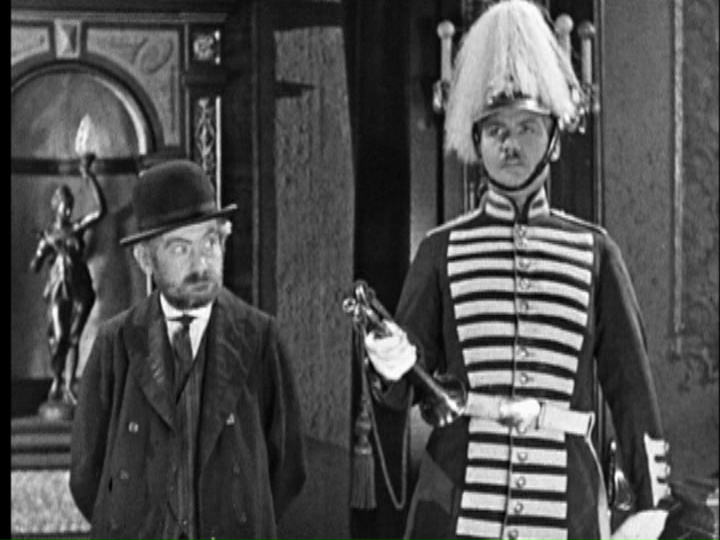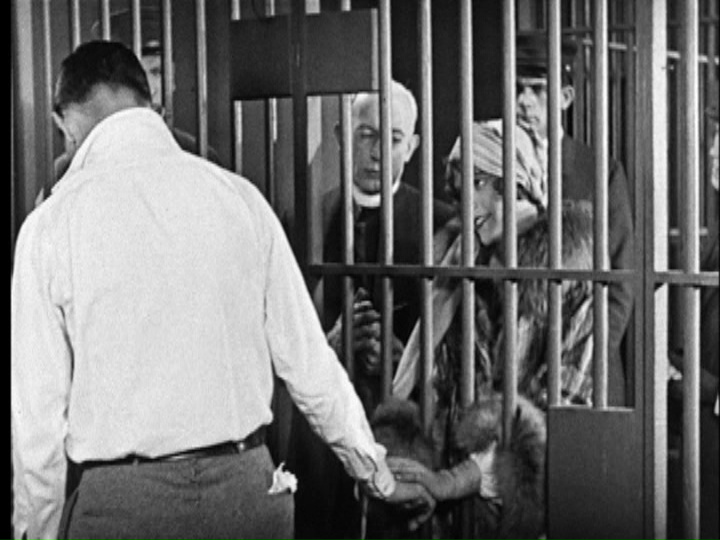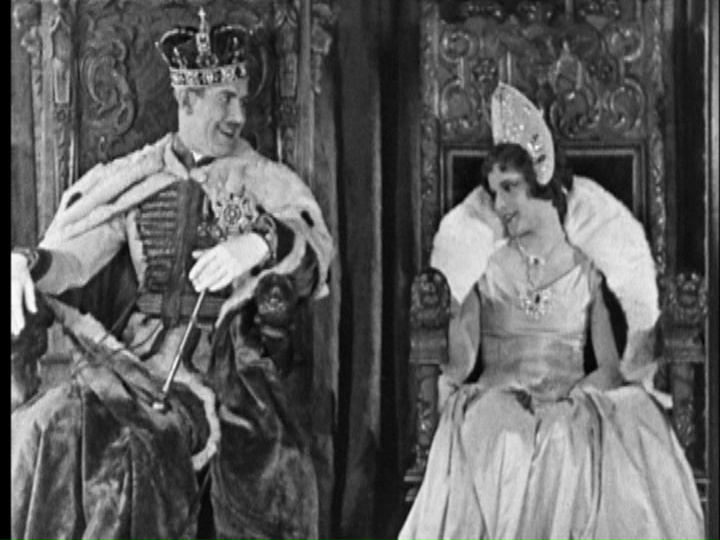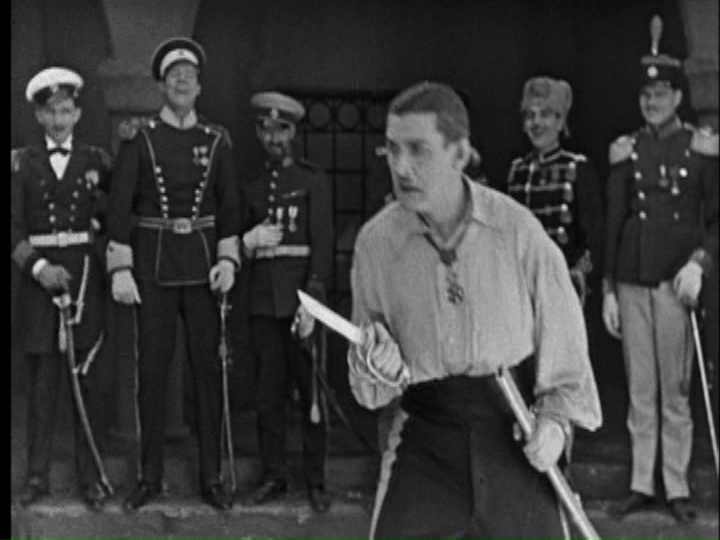A princess visiting America receives news that she must marry within twenty-four hours to inherit the throne. The obvious answer: marry a convict set to be hanged! The governor’s last-minute pardon ruins the plan for rapid widowhood and the bridegroom suddenly finds himself king. Charley Chase, Martha Sleeper and Max Davidson clearly had a lot of fun with this one.
Home Media Availability: Released on DVD.
The Royal Reprieve
Charley Chase is among my very favorite silent era comedians, so it was natural that he would also jump into the popular Ruritanian spoof genre. Backed up by some of the Hal Roach studio’s finest talent, Chase scored a hit with Long Fliv the King. Directed by Leo McCarey, titles by Beanie Walker, co-starring Martha Sleeper, Max Davidson and Oliver Hardy… How can we possibly miss? (Spoiler: We don’t.)
The short opens with Princess Helga of Thermosa (Sleeper) receiving word from her rival for the throne and would-be suitor, Hamir of Uvocado (Fred Malatesta), that she must get married in twenty-four hours or forfeit the throne. Since she has gone shopping in America and has no suitor close at hand, it seems that she will miss out on ruling the kingdom and have to marry Hamir.
The “you get the dough provided you’re married” plot device is often associated with the 1916 David Belasco-produced play Seven Chances by Roi Cooper Megrue and its 1925 film adaptation starring Buster Keaton. However, the trope was older than that and can be seen as a warhorse even before Belasco got in on the act. You can see a 1911 version it in Three Million Dollars, in which a young woman must marry to inherit and her father will do anything—including kidnapping a groom—to see that the wedding happens on schedule.
Princess Helga seems to be trapped—how can she marry someone she’s known for just a day?—but her maid provides the answer: a news item about a man convicted of a capital offense and scheduled to be executed withing twenty-four hours. Helga agrees, the convict agrees, the marriage is quickly performed and that is that.
Or is it? The groom is Charley Chase, of course, and just after the princess leaves, the governor’s pardon is delivered. Lefty Leo has confessed and cleared his name! (“Lefty Leo” likely being an in-joke reference to director Leo McCarey.) Charley dashes out of the jail to find his royal bride but he needs a car. Enter Max Davidson as Warfield, who doesn’t believe Charley’s ravings about claiming a kingdom—at first.
Back in Thermosa, Helga is about to be crowned when her husband makes his entrance to claim his rights. Any potential creepiness is headed off because Helga is utterly delighted that Charley survived and has come to be her husband. She always thought he was cute. Meanwhile, Hamir and his wicked henchman, Oliver Hardy (complete with villain mustache), scheme to goad Charley into a duel. After several practical jokes and one crown filled with melted ice cream, they succeed.
Without a doubt, the comedic highlight of Long Fliv the King is the dueling scene. Chase prances around with a giant scabbard—we know it likely contains a tiny dagger and the filmmakers knew that we would know and they tease and tease and tease—and then attempts to duel with soldiers carrying a stretcher behind him to carry off his body for burial. Warfield makes matters worse by narrating Charley’s peril but ends up saving the day with a well-timed poisoning.
Davidson’s legacy in films can be safely described as complicated. A Jewish man himself, he was a genuinely hilarious performer who also traded in some pretty broad stereotypes. Warfield is greedy and coarse and there is even a ham-eating sequence in the film. But Davidson and Chase play against one another beautifully, especially in scenes that allow them to just play to the camera. For example, their joint reaction to seeing Hamir dispatch three mighty duelists offscreen. Comedy gold with gestures and expressions alone.
Frequent Chase supporting players Oliver Hardy and Martha Sleeper are not quite as prominently featured but are amusing nonetheless. Fred Malatesta, as the main heavy, probably has the straightest part in the picture but he’s not above a broad wink and a squirting buttonhole. All in all, everyone is at their best.
Long Fliv the King is often called a remake of the 1920 Harold Lloyd short His Royal Slyness but the two films have very little in common besides an American becoming the king of a kingdom named Thermosa. In His Royal Slyness, Lloyd’s unscrupulous character willingly participates in a scam to allow the lookalike heir to the throne chase an American vamp while Lloyd takes on the royal duties back home. It ends with Lloyd accidentally aiding a Bolshevik uprising and accepting the new position as president in the People’s Republic of Thermosa. Snub Pollard plays Lloyd’s rival for the hand of Mildred Davis but he’s a purely comedic figure and not a particularly menacing threat.
Chase, on the other hand, truly is the king even if Helga didn’t entirely intend for the marriage to last. Still, he’s cute and she digs him. Much of the film is spent dealing with the nefarious Hamir of Uvocado, who wants to kill Chase and plays for keeps. Rather than fomenting a revolution, Chase must flee because Hamir has the support of the populace. In the end, Chase gets Helga, which was all he cared about, and the pair make their escape by steamship with Warfield, leaving the possibly poisoned aristocracy of Thermosa to shake their fists helplessly.
However, both films espouse what was a common sentiment at the time: royalty is for the birds. In addition to these shorts, you can see Americans dabbling with nobility and then discarding it in Reaching for the Moon and Young April. In a modern pop culture landscape full of Christmas Princes, Disney Princesses and “elected” space queens, it’s fascinating to see earlier films beating the pro-democracy drum. The context for all this was, of course, multiple European royal families dropping like flies, either abdicating, transferring to symbolic roles or experiencing a violent removal. There is a definite tone of “I told you so!”
I did prefer Long Fliv the King over His Royal Slyness if we want to get into the direct comparison game, but I think fans of both comedians will find something to enjoy and they’re both short films, so why not enjoy a little double feature and make your own choice? And both pictures have delightfully bad puns as titles. His Royal Slyness is, of course, a play on his royal highness but Long Fliv the King may be less obvious. The term “flivver” was a popular term for a cheap car but it could also mean to fail. Chase also makes his climactic escape by motor car, so perhaps there was a double pun.
Long Fliv the King is a perfectly delightful entry in the Charley Chase canon and his interplay with Max Davidson is particularly amusing, though the stereotypes do mar the fun. It features some particularly witty set pieces and the enthusiastic supporting cast, a typical feature of a Chase comedy, enhances the film enormously. Chase remains my silent comedy darling.
Where can I see it?
Released on DVD by Kino as part of their Charley Chase set.
☙❦❧
Like what you’re reading? Please consider sponsoring me on Patreon. All patrons will get early previews of upcoming features, exclusive polls and other goodies.
Disclosure: Some links included in this post may be affiliate links to products sold by Amazon and as an Amazon Associate I earn from qualifying purchases.







